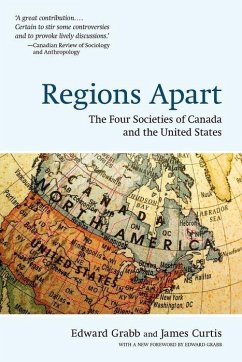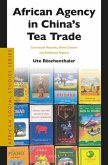- Broschiertes Buch
- Merkliste
- Auf die Merkliste
- Bewerten Bewerten
- Teilen
- Produkt teilen
- Produkterinnerung
- Produkterinnerung
This book provides an invaluable social, cultural, and political comparison of the two countries that share the world's longest undefended border--Canada and the United States. General readers and students alike will find Regions Apart an insightful analysis of how and why Americans and Canadians differ, not only from each other but from region to region within each country.
Andere Kunden interessierten sich auch für
![The Regions Of Vegetation, Being An Analysis Of The Distribution Of Vegetable Forms Over The Surface Of The Globe In Connection With Climate And Physi The Regions Of Vegetation, Being An Analysis Of The Distribution Of Vegetable Forms Over The Surface Of The Globe In Connection With Climate And Physi]() Hinds Richard BrinsleyThe Regions Of Vegetation, Being An Analysis Of The Distribution Of Vegetable Forms Over The Surface Of The Globe In Connection With Climate And Physi21,99 €
Hinds Richard BrinsleyThe Regions Of Vegetation, Being An Analysis Of The Distribution Of Vegetable Forms Over The Surface Of The Globe In Connection With Climate And Physi21,99 €![Descriptions of New Genera and Species of Isopoda From New England and Adjacent Regions Descriptions of New Genera and Species of Isopoda From New England and Adjacent Regions]() Oscar HargerDescriptions of New Genera and Species of Isopoda From New England and Adjacent Regions15,99 €
Oscar HargerDescriptions of New Genera and Species of Isopoda From New England and Adjacent Regions15,99 €![African Agency in China's Tea Trade African Agency in China's Tea Trade]() Ute RöschenthalerAfrican Agency in China's Tea Trade107,99 €
Ute RöschenthalerAfrican Agency in China's Tea Trade107,99 €![Plant Physics Plant Physics]() Karl J NiklasPlant Physics56,99 €
Karl J NiklasPlant Physics56,99 €![A Field Guide to Plants of Costa Rica A Field Guide to Plants of Costa Rica]() Margaret GargiulloA Field Guide to Plants of Costa Rica40,99 €
Margaret GargiulloA Field Guide to Plants of Costa Rica40,99 €![Field Guide to Fynbos Field Guide to Fynbos]() John ManningField Guide to Fynbos29,99 €
John ManningField Guide to Fynbos29,99 €![Methods in Comparative Plant Population Ecology (Revised) Methods in Comparative Plant Population Ecology (Revised)]() David GibsonMethods in Comparative Plant Population Ecology (Revised)96,99 €
David GibsonMethods in Comparative Plant Population Ecology (Revised)96,99 €-
-
-
This book provides an invaluable social, cultural, and political comparison of the two countries that share the world's longest undefended border--Canada and the United States. General readers and students alike will find Regions Apart an insightful analysis of how and why Americans and Canadians differ, not only from each other but from region to region within each country.
Hinweis: Dieser Artikel kann nur an eine deutsche Lieferadresse ausgeliefert werden.
Hinweis: Dieser Artikel kann nur an eine deutsche Lieferadresse ausgeliefert werden.
Produktdetails
- Produktdetails
- Verlag: Hurst & Co.
- Wynford edition
- Seitenzahl: 344
- Erscheinungstermin: 15. Juni 2010
- Englisch
- Abmessung: 229mm x 164mm x 14mm
- Gewicht: 313g
- ISBN-13: 9780195438307
- ISBN-10: 0195438302
- Artikelnr.: 32209486
- Herstellerkennzeichnung
- Libri GmbH
- Europaallee 1
- 36244 Bad Hersfeld
- gpsr@libri.de
- Verlag: Hurst & Co.
- Wynford edition
- Seitenzahl: 344
- Erscheinungstermin: 15. Juni 2010
- Englisch
- Abmessung: 229mm x 164mm x 14mm
- Gewicht: 313g
- ISBN-13: 9780195438307
- ISBN-10: 0195438302
- Artikelnr.: 32209486
- Herstellerkennzeichnung
- Libri GmbH
- Europaallee 1
- 36244 Bad Hersfeld
- gpsr@libri.de
Edward Grabb is Professor and Senior Scholar in Residence at the Department of Sociology at the University of British Columbia. Most of his research centres on social inequality, political sociology, and comparative social structure. His articles have appeared in such journals as the American Sociological Review, Social Forces, the Canadian Journal of Political Science, and the Canadian Journal of Sociology. His other books include Social Inequality in Canada: Patterns, Problems, and Policies (co-edited with Neil Guppy) and Theories of Social Inequality. The late James Curtis was a professor in the Department of Sociology at the University of Waterloo. His primary scholarly interests included social inequality, associational and political behaviour, the sociology of knowledge, and the sociology of physical activity and sport.
* Introduction to the Wynford Edition
* Preface
* Introduction
* Plan of the Book
* Part I: Canada and the United States: Theoretical Perspectives
* Introduction
* 2: Previous Perspectives: Founding Fragements and Revolutionary
Origins
* Hartz's Theory of European Founding Fragements
* Lipset's Origins Thesis: The Defining Moment of the American
Revolution
* Summary
* 3: An Alternative Perspective: Deep Structures and the Four
Sub-societies of Canada and the United States
* The Concept of Deep Structures
* Deep Structures and the English Heritage
* Identifying the Deep Structures of the English Societies
* Canada and the United States as Four Sub-societies
* Summary and Conclusion to Part I
* Part II: Historical Myths and Historical Evidence
* Introduction
* 4: Liberty, Liberalism, and the Myth of American Individualism
* The Concept of Liberty in Pre-revolutionary America
* The Myth of American Individualism
* Summary
* 5: English Canada and the Loyalist Myth
* The Loyalist Migration and Canadian Toryism
* Counting the Loyalists
* How Loyal Were the Loyalists?
* Were the English-Canadian Colonists 'Americans'?
* Tory Values: Comparing the Elite and the Larger Population
* Summary
* 6: Canadians and Americans: Historical Comparisons
* Class Structure and Economic Background
* Ethnic Composition and Sources of Immigration
* Religion in Canada and the United States
* Patterns of Urbanization
* Political Culture and Organization
* Summary
* Conclusion to Part II
* Part III: Enduring Myths and Contemporary Realities
* Introduction
* Samples and Data Sources
* Research Questions
* 7: Moral Issues: Religion, Family Values, and Crime
* Religion and Religiosity
* Family and Sexual Values
* Crime and the Law
* Summary
* 8: Individualism, Collectivism, and the State
* Collectivism and the Role of the State
* Attitudes about Individualism, Statism, and Collectivism
* Summary
* 9: Social Inclusion and Tolerance toward Minorities
* Mosaic and Melting Pot
* Patterns of Immigration and Racial Composition
* Socioeconomic Attainments of Immigrants and Ethnic Minorities
* Comparative Research on Attitudes toward Minorities
* Summary
* 10: Political Attitudes and Political Action
* Political Interest and Political Behaviour
* Political Trust and Confidence in Government
* Feelings of Interpersonal Trust and National Pride
* Summary
* 11: Voluntary-Association Involvement and Activity
* Previous Research
* Results from the World Values Surveys
* Summary
* Conclusion to Part III
* 12: Conclusion
* Deep Structures Revisited
* How Many 'Nations' Are There?
* Elites and Masses
* National Differences: Comparing the Extremes
* Past, Present, and Future: Convergence, Divergence, or Both?
* Appendix I
* Appendix II
* Appendix III
* References
* Index
* Preface
* Introduction
* Plan of the Book
* Part I: Canada and the United States: Theoretical Perspectives
* Introduction
* 2: Previous Perspectives: Founding Fragements and Revolutionary
Origins
* Hartz's Theory of European Founding Fragements
* Lipset's Origins Thesis: The Defining Moment of the American
Revolution
* Summary
* 3: An Alternative Perspective: Deep Structures and the Four
Sub-societies of Canada and the United States
* The Concept of Deep Structures
* Deep Structures and the English Heritage
* Identifying the Deep Structures of the English Societies
* Canada and the United States as Four Sub-societies
* Summary and Conclusion to Part I
* Part II: Historical Myths and Historical Evidence
* Introduction
* 4: Liberty, Liberalism, and the Myth of American Individualism
* The Concept of Liberty in Pre-revolutionary America
* The Myth of American Individualism
* Summary
* 5: English Canada and the Loyalist Myth
* The Loyalist Migration and Canadian Toryism
* Counting the Loyalists
* How Loyal Were the Loyalists?
* Were the English-Canadian Colonists 'Americans'?
* Tory Values: Comparing the Elite and the Larger Population
* Summary
* 6: Canadians and Americans: Historical Comparisons
* Class Structure and Economic Background
* Ethnic Composition and Sources of Immigration
* Religion in Canada and the United States
* Patterns of Urbanization
* Political Culture and Organization
* Summary
* Conclusion to Part II
* Part III: Enduring Myths and Contemporary Realities
* Introduction
* Samples and Data Sources
* Research Questions
* 7: Moral Issues: Religion, Family Values, and Crime
* Religion and Religiosity
* Family and Sexual Values
* Crime and the Law
* Summary
* 8: Individualism, Collectivism, and the State
* Collectivism and the Role of the State
* Attitudes about Individualism, Statism, and Collectivism
* Summary
* 9: Social Inclusion and Tolerance toward Minorities
* Mosaic and Melting Pot
* Patterns of Immigration and Racial Composition
* Socioeconomic Attainments of Immigrants and Ethnic Minorities
* Comparative Research on Attitudes toward Minorities
* Summary
* 10: Political Attitudes and Political Action
* Political Interest and Political Behaviour
* Political Trust and Confidence in Government
* Feelings of Interpersonal Trust and National Pride
* Summary
* 11: Voluntary-Association Involvement and Activity
* Previous Research
* Results from the World Values Surveys
* Summary
* Conclusion to Part III
* 12: Conclusion
* Deep Structures Revisited
* How Many 'Nations' Are There?
* Elites and Masses
* National Differences: Comparing the Extremes
* Past, Present, and Future: Convergence, Divergence, or Both?
* Appendix I
* Appendix II
* Appendix III
* References
* Index
* Introduction to the Wynford Edition
* Preface
* Introduction
* Plan of the Book
* Part I: Canada and the United States: Theoretical Perspectives
* Introduction
* 2: Previous Perspectives: Founding Fragements and Revolutionary
Origins
* Hartz's Theory of European Founding Fragements
* Lipset's Origins Thesis: The Defining Moment of the American
Revolution
* Summary
* 3: An Alternative Perspective: Deep Structures and the Four
Sub-societies of Canada and the United States
* The Concept of Deep Structures
* Deep Structures and the English Heritage
* Identifying the Deep Structures of the English Societies
* Canada and the United States as Four Sub-societies
* Summary and Conclusion to Part I
* Part II: Historical Myths and Historical Evidence
* Introduction
* 4: Liberty, Liberalism, and the Myth of American Individualism
* The Concept of Liberty in Pre-revolutionary America
* The Myth of American Individualism
* Summary
* 5: English Canada and the Loyalist Myth
* The Loyalist Migration and Canadian Toryism
* Counting the Loyalists
* How Loyal Were the Loyalists?
* Were the English-Canadian Colonists 'Americans'?
* Tory Values: Comparing the Elite and the Larger Population
* Summary
* 6: Canadians and Americans: Historical Comparisons
* Class Structure and Economic Background
* Ethnic Composition and Sources of Immigration
* Religion in Canada and the United States
* Patterns of Urbanization
* Political Culture and Organization
* Summary
* Conclusion to Part II
* Part III: Enduring Myths and Contemporary Realities
* Introduction
* Samples and Data Sources
* Research Questions
* 7: Moral Issues: Religion, Family Values, and Crime
* Religion and Religiosity
* Family and Sexual Values
* Crime and the Law
* Summary
* 8: Individualism, Collectivism, and the State
* Collectivism and the Role of the State
* Attitudes about Individualism, Statism, and Collectivism
* Summary
* 9: Social Inclusion and Tolerance toward Minorities
* Mosaic and Melting Pot
* Patterns of Immigration and Racial Composition
* Socioeconomic Attainments of Immigrants and Ethnic Minorities
* Comparative Research on Attitudes toward Minorities
* Summary
* 10: Political Attitudes and Political Action
* Political Interest and Political Behaviour
* Political Trust and Confidence in Government
* Feelings of Interpersonal Trust and National Pride
* Summary
* 11: Voluntary-Association Involvement and Activity
* Previous Research
* Results from the World Values Surveys
* Summary
* Conclusion to Part III
* 12: Conclusion
* Deep Structures Revisited
* How Many 'Nations' Are There?
* Elites and Masses
* National Differences: Comparing the Extremes
* Past, Present, and Future: Convergence, Divergence, or Both?
* Appendix I
* Appendix II
* Appendix III
* References
* Index
* Preface
* Introduction
* Plan of the Book
* Part I: Canada and the United States: Theoretical Perspectives
* Introduction
* 2: Previous Perspectives: Founding Fragements and Revolutionary
Origins
* Hartz's Theory of European Founding Fragements
* Lipset's Origins Thesis: The Defining Moment of the American
Revolution
* Summary
* 3: An Alternative Perspective: Deep Structures and the Four
Sub-societies of Canada and the United States
* The Concept of Deep Structures
* Deep Structures and the English Heritage
* Identifying the Deep Structures of the English Societies
* Canada and the United States as Four Sub-societies
* Summary and Conclusion to Part I
* Part II: Historical Myths and Historical Evidence
* Introduction
* 4: Liberty, Liberalism, and the Myth of American Individualism
* The Concept of Liberty in Pre-revolutionary America
* The Myth of American Individualism
* Summary
* 5: English Canada and the Loyalist Myth
* The Loyalist Migration and Canadian Toryism
* Counting the Loyalists
* How Loyal Were the Loyalists?
* Were the English-Canadian Colonists 'Americans'?
* Tory Values: Comparing the Elite and the Larger Population
* Summary
* 6: Canadians and Americans: Historical Comparisons
* Class Structure and Economic Background
* Ethnic Composition and Sources of Immigration
* Religion in Canada and the United States
* Patterns of Urbanization
* Political Culture and Organization
* Summary
* Conclusion to Part II
* Part III: Enduring Myths and Contemporary Realities
* Introduction
* Samples and Data Sources
* Research Questions
* 7: Moral Issues: Religion, Family Values, and Crime
* Religion and Religiosity
* Family and Sexual Values
* Crime and the Law
* Summary
* 8: Individualism, Collectivism, and the State
* Collectivism and the Role of the State
* Attitudes about Individualism, Statism, and Collectivism
* Summary
* 9: Social Inclusion and Tolerance toward Minorities
* Mosaic and Melting Pot
* Patterns of Immigration and Racial Composition
* Socioeconomic Attainments of Immigrants and Ethnic Minorities
* Comparative Research on Attitudes toward Minorities
* Summary
* 10: Political Attitudes and Political Action
* Political Interest and Political Behaviour
* Political Trust and Confidence in Government
* Feelings of Interpersonal Trust and National Pride
* Summary
* 11: Voluntary-Association Involvement and Activity
* Previous Research
* Results from the World Values Surveys
* Summary
* Conclusion to Part III
* 12: Conclusion
* Deep Structures Revisited
* How Many 'Nations' Are There?
* Elites and Masses
* National Differences: Comparing the Extremes
* Past, Present, and Future: Convergence, Divergence, or Both?
* Appendix I
* Appendix II
* Appendix III
* References
* Index








